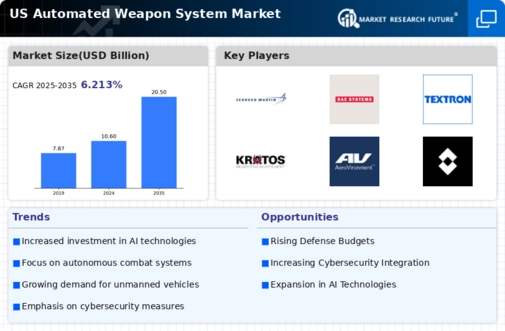Rising Geopolitical Tensions
The automated weapon-system market is experiencing growth due to escalating geopolitical tensions. This is particularly true in regions where military capabilities are being rapidly enhanced. Nations are increasingly investing in advanced automated systems to maintain strategic advantages. For instance, the US defense budget for 2025 allocates approximately $800 billion, with a significant portion directed towards automated systems. This trend indicates a shift towards integrating technology in defense strategies, as countries seek to deter potential threats. The automated weapon-system market is thus likely to benefit from these heightened security concerns, as military forces prioritize investments in automation to enhance operational efficiency and effectiveness.
Increased Focus on Cybersecurity
As the automated weapon-system market evolves, there is an increasing emphasis on cybersecurity measures to protect these advanced systems from potential threats. The US military acknowledges that automated systems are vulnerable to cyberattacks, which could compromise operational integrity. In response, defense agencies are investing heavily in cybersecurity solutions, with estimates suggesting a budget increase of 15% for cybersecurity initiatives in 2025. This focus on securing automated systems is likely to drive innovation within the market, as manufacturers develop more robust security features to safeguard against cyber threats, thereby enhancing the overall reliability of automated weapon systems.
Shift Towards Autonomous Systems
The automated weapon-system market is witnessing a notable shift. This shift is towards the development and deployment of fully autonomous systems. This trend is driven by advancements in robotics and AI, which enable systems to operate independently in various combat scenarios. The US military is actively exploring the use of unmanned systems, with plans to increase their presence in future operations. Reports indicate that the budget for autonomous systems is projected to grow by 20% over the next five years. This shift towards autonomy is likely to reshape the automated weapon-system market, as military forces seek to leverage these technologies for enhanced operational capabilities and reduced risk to personnel.
Demand for Enhanced Operational Efficiency
In the automated weapon-system market, there is a growing demand for enhanced operational efficiency among military forces. Automated systems are perceived to reduce human error and increase precision in combat scenarios. The US military's focus on modernization has led to the integration of automated systems in various operations, which reportedly improves mission success rates by up to 30%. This drive for efficiency is compelling defense contractors to innovate and develop more sophisticated automated solutions. As a result, the automated weapon-system market is poised for expansion, as military organizations seek to leverage technology to optimize their operational capabilities.
Technological Integration in Defense Strategies
The automated weapon-system market is significantly influenced by the integration of advanced technologies. These technologies include artificial intelligence (AI) and machine learning. These technologies are being incorporated into weapon systems to enhance decision-making processes and operational capabilities. The US Department of Defense has recognized the potential of AI, investing over $1 billion in AI research and development for military applications. This integration is expected to revolutionize the automated weapon-system market, as systems become more autonomous and capable of complex tasks. Consequently, the market is likely to see a surge in demand for innovative automated solutions that can adapt to evolving combat environments.

















Leave a Comment